Day: September 1, 2025

A Litmus Test for Bangladesh Economy
It began with a verdict. Not a speech, not a scandal—just a quiet ruling from Bangladesh’s judiciary. On June 5, 2024, the High Court reinstated a quota system for government jobs, reserving 56 percent of positions for specific groups, including descendants of freedom fighters. For many students, it felt like a door slamming shut. Within days, campuses across the country stirred with frustration. The movement that followed—Students Against Discrimination—was born not in fury, but in resolve. Their rallies were orderly, their chants measured. But beneath the surface, tension simmered. By early July, that tension boiled over. The protests evolved into the “Bangla Blockade,” a sweeping shutdown of roads and highways that paralysed the nation’s arteries. Buses vanished. Containers stacked up at ports. Supply trucks idled outside factories. Dhaka’s markets emptied as perishables spoiled in the heat. Exporters missed deadlines. Small traders watched their earnings evaporate. What began as a student movement had metastasized into an economic crisis. DEFINING MOMENTS June 5 | 2024 High Court reinstates quotas June 7-15 | 2024 Students begin peaceful rally, social media activism July 01 | 2024 Nationwide Bangla Blockade begins July 16 | 2024 Violent crackdown, leaving dozens killed Late July | 2024 FDI approvals drop 40%; export delays, gas shortages August 5 | 2024 Interim Government formed Sep–Dec | 2024 Interest hits 10%; ADP spending 49-year low Jan–Mar | 2025 Remittances peak; inflation eases; current account surplus Apr–Jul | 2025 Recovery phase: DSEX up 12.5%; exports rebound; MFS grows 64% August 5 | 2025 One-Year Anniversary A Nation on Edge On July 16 of 2024, the calm shattered. Security forces moved in with batons, tear gas, and live ammunition. The clashes were brutal. Ambulances raced through smoke-filled streets. Students lay bloodied on stretchers. Families camped outside police stations, desperate for news. Independent monitors reported hundreds injured and dozens dead. The government disputed the numbers. But the images—broadcast across television screens and social media—left little room for doubt. The shockwaves were immediate. Investor confidence collapsed. The Dhaka Stock Exchange saw its sharpest single-day drop in five years. Foreign direct investment approvals fell nearly 40 percent in the second half of 2024, according to the Dhaka Chamber of Commerce and Industry. The city, once buzzing with commerce, fell into a hush. Three weeks later on August 5, an interim government was announced, led by Nobel laureate Muhammad Yunus along with a panel of technocrats and civil society leaders. Their mandate: restore stability, rebuild trust, and prevent further economic unraveling. The Economic Aftershocks The July Uprising, as it came to be known, left no sector untouched. While the garment and ceramic sectors bore the immediate brunt, the ripple effects extended far wider. The banking system, already strained by years of financial irregularities, teetered on collapse. A post-uprising asset quality review revealed widespread non-performing loans and misappropriated funds, prompting the interim government to initiate recovery drives and liquidity injections. The Bangladesh Bank raised the policy rate to 10 percent to tame inflation and stabilise the exchange rate. Net foreign direct investment (FDI) dropped to a five-year low in 2024, as global investors cited political instability and opaque regulatory frameworks. The World Bank flagged Bangladesh’s deteriorating investment climate, while local chambers warned that the budget lacked a clear roadmap for restoring investor confidence. The energy sector faced dual shocks: gas shortages crippled industrial output, while privatisation efforts triggered an 18 percent hike in urban electricity tariffs, sparking fresh protests. The mental health toll was staggering. A Bangladesh Medical University seminar revealed that 82.5% of injured protesters suffered from depression, and 64% showed signs of post-traumatic stress disorder, underscoring the long-term human cost of the crisis. In the ceramic industry, 70 factories struggled to stay afloat. The Bangladesh Ceramic Manufacturers and Exporters Association (BCMEA) reported that gas pressure—critical for kiln operations—dropped to as low as 2 PSI in some zones, far below the required 15. Production stalled. Costs soared. Their demands were precise: uninterrupted gas supply, priority allocation, compressor permissions, a five-year tariff freeze, and duty-free solar imports. None were met. The garment sector fared no better. The Bangladesh Garment Manufacturers and Exporters Association (BGMEA) confirmed shipment delays averaging two weeks during the unrest. Export Promotion Bureau (EPB) data showed a 7.8% decline in garment exports in Q3 of 2024. Buyers in Europe and North America have shifted orders to Vietnam and India. Smaller exporters faced penalties and lost contracts, according to the Bangladesh Knitwear Manufacturers and Exporters Association (BKMEA). The Foreign Investors’ Chamber of Commerce and Industry (FICCI) called for stronger rule of law, faster customs clearance, and smoother approvals. The Bangladesh Chamber of Industries (BCI) highlighted the plight of agro-processors, many of whom faced wastage and layoffs. Their appeal: concessional loans and tax relief. Even real estate, long seen as a safe haven, stumbled. The Real Estate and Housing Association of Bangladesh (REHAB) reported a sharp drop in property transactions, citing high registration fees, interest rates, and uncertainty over the Detailed Area Plan (DAP) revisions. Across industries, the message converged: without urgent reform, Bangladesh’s hard-earned gains risked slipping away. The Numbers Behind the Crisis The numbers told a sobering story. By late 2024, exports faltered, imports shrank, and growth slowed to its weakest pace in years. The disruptions that began with student protests soon seeped into every corner of the economy, from factories to food markets. Inflation surged through the summer, eroding wages and squeezing households already under strain. Though the pace of price rises eased the following year, the scars remained. Construction sites went quiet, housing demand collapsed, and long-promised infrastructure projects were postponed. The slowdown was no longer abstract—it showed in half-finished bridges and shuttered shops. Private investment also lost its footing. Business registrations dwindled, banks groaned under bad loans, and confidence withered. Even as revenue collection improved, it could not
Read More
The Spatial Journey of Architect Naimul Ahsan
Architecture begins with a dream, but its true value lies in design—making buildings easy to construct, comfortable to inhabit, and meaningful for those who live in them. This is the guiding principle of Naimul Ahsan Khan, founder of Spatial Architects, who spoke about his philosophy on a calm evening in his studio. For Khan, architecture exists for the people. Simplicity is not just aesthetic but ethical—a way to make spaces accessible, functional, and enduring. His career, marked by both imagination and pragmatism, reflects this belief. After graduating from BUET in 2006, Khan began his professional journey at VITTI Sthapati Brinda Ltd., while teaching at the University of Asia Pacific, later joining S. Islam Consultants to gain formative experience. Yet even before these formal beginnings, in 2005, he co-founded Matra Architects with three friends, working from a small room at Sher-e-Bangla Hall before moving to Kalabagan. Though the firm dissolved in 2009, it set Khan on the path to independent practice. That same year, he and his wife, architect Farzana Rahman, established Spatial Architects, which has since delivered over 200 projects across Bangladesh. Khan’s design philosophy is rooted in modernist minimalism, inspired by Mies van der Rohe’s dictum “less is more.” But he translates this principle into a distinctly Bangladeshi context, using simple forms, local materials, and designs that respond to everyday life. Tagore’s words— “simple words are not easy to say”—resonate with him; simplicity in architecture is often the hardest to achieve. Influenced also by Arundhati Roy, who abandoned architecture because of its alienating language, Khan strives to make his work understandable to ordinary people. This approach is evident in his most celebrated project, Shikor. More than a farmhouse, it is a journey back to rural roots, connecting four generations of the family it was designed for. The design process was deceptively simple: reinterpret elements of rural architecture in a universal, contemporary language. The project transformed the surrounding village, too—muddy roads were paved, solar lights brightened the nights, and a community library was built. “A city family reconnecting with their village changed the village itself,” Khan reflects. In Chattogram, his Chandrapuray Kichukhon project challenges the dominance of isolated urban apartments. The nine-storey residence, designed for an extended family, revolves around courtyards, gardens, and communal spaces, reviving collective living in a dense city. “We won’t be here forever, but the memories will remain,” the clients told Spatial Architects—a vision the design honours. Even religious projects follow Khan’s principle of restraint. In Narsingdi, the Baitul Mamur Mosque occupies a modest 55 by 25 feet plot. “It’s such a small piece of land—nothing conventional could be built, so we decided not to force anything,” he explains. Instead, perforated brick walls breathe, and a lightweight metal roof allows air and sunlight to flow freely, creating a spiritual space that feels open and alive. Khan’s influence extends into education architecture. Working with the Education Engineering Department, he is reshaping rigid, prison-like school layouts into environments that foster joy, safety, and learning—a quiet revolution in the country’s classrooms. His work has earned international acclaim: First Prize in the Fael Khair Programme International Competition (2009), the Gold Diploma at the Eurasian Prize (2021, Russia), Best of Best at the Architecture Master Prize (2021, California), and First Prize in the NESCO Head Office Complex Competition (2024). Yet for Khan, success is measured not in awards but in client satisfaction. “I want to put my clients first. Their satisfaction is my real achievement,” he says. Sustainability, for him, is local. “Being local is sustainable,” he asserts, advocating for indigenous materials and designs that respond to climate, context, and community. Initially skeptical contractors come to appreciate the clarity of his solutions, and over time, he has built trusted teams of masons and builders who “understand his language”. Khan is equally outspoken about urban planning in Bangladesh. “We’ve done master plans and detailed area plans, but what we need is urban design,” he insists, warning against overburdening Dhaka and urging development in other cities. He is critical of RAJUK, which he sees as prioritizing promotion over development, emphasizing that regulations must be transparent and serve the public. Deeply influenced by Bashirul Haque and Mazharul Islam, Khan consults their work when in doubt. He admires contemporaries like Kashef Mahbub Chowdhury and Marina Tabassum, while following global figures such as Tadao Ando. He also champions architectural publications, asking, “A hundred years from now, how will people know what Bangladeshi architecture was like?” For him, publications bridge architects and the wider public. Optimistic about the younger generation, he says, “They’re smarter than us. They don’t need our advice.” Yet he encourages students to study more about Bangladesh if they intend to practice locally. Khan’s buildings do not compete for attention—they settle into their surroundings, listening to the land, the people, and the passage of time. For him, architecture is a lived experience, not an abstract statement. By making it easy to build, easy to inhabit, and easy to love, he has created a practice that resonates deeply with the essence of Bangladesh itself. Written By Arefin Murad
Read More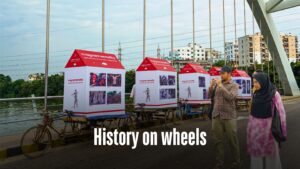
Dhaka’s Moving Tribute to July Revolution
Pedestrians paused in silence, bus conductors gazed from their windows—some recognising familiar faces, others lost in painful memories. A powerful street exhibition in Dhaka displayed haunting images from Bangladesh’s July 2024 Mass Uprising, bringing the city’s recent trauma into public view. “While traditional galleries in Dhaka often cater to only a certain class of people, a floating street exhibition was envisioned as a way to bring art into public spaces—making it accessible to people from all walks of life,” says Taslima Akhter, the acclaimed photojournalist and activist who organised the event alongside Pathshala South Asian Media Institute. On August 11-12 of 2025, five exhibition vans set out from the Raju Memorial Sculpture at Dhaka University, bringing the story of the July Uprising to the streets of Dhaka, covering most of the significant spots where the revolution took place. The key aspects of this floating exhibition were to demonstrate the participation of students, professionals, everyday people—especially women—and the significance of D-Day, August 5. Creatively set up on vans, photographs and artworks were mounted on temporary house-like structures with striking red roofs, drawing the attention of day labourers, students, office workers, chauffeurs, and people from all walks of life—just as they once came together to free the country from the 15-year authoritarian regime under Sheikh Hasina’s government. The vans stopped at key sites of the uprising, letting visitors engage with the images. Organisers admitted the street exhibition was challenging—but they were committed to reaching as many people as possible. Originally planned to honour the martyrs on the uprising’s first anniversary, the exhibition was postponed due to logistical challenges. “What you see now is a collection of the works we were able to gather, with consent from the participating photographers,” said Taslima. She further said how we’re not only fighting the effects of fascist ideology in our society, but also confronting it within our own thought processes. In the past, many artists and photographers hesitated to share their work—uncertain whether to publish without captions, or anxious about choosing the right words. But now, we’re seeing more and more artists overcome that fear, driven by a collective urge to tell the truth through their work. When asked about the downside of everyone having a camera in their hands today, Taslima shared a different perspective. On the contrary, she explained how portable devices have empowered not just photographers but everyday people to document history like never before. If it weren’t for ordinary citizens, much of the horror of the July revolution across the country would have gone unseen. What was once a tool for personal use has now become a powerful instrument for capturing and sharing the truth. Exhibitions like this mark a crucial shift in the power dynamics of information. They democratise memory, ensuring the story of the revolution belongs to everyone—not just a privileged few. They also remind us that art and photography are powerful tools of resistance and collective remembrance. Written by Fariha Hossain Photo: Md. Rasel Ahmed
Read More
Meghna Ceramic’s Fresh brand redefining Bangladesh’s ceramic industry
Sustainability, innovation, and design leadership define Meghna Ceramic Industries Ltd. (MCIL), a concern of Meghna Group of Industries (MGI). Since its establishment in 2021 under the brand Fresh Ceramics, the company has rapidly grown into one of Bangladesh’s leading tile manufacturers while setting new benchmarks in responsible ceramic production. Nestled in Ashariar Char of Meghnaghat, Sonargaon, Narayanganj — nearly 39 kilometres from the capital Dhaka — MCIL boasts the highest tile production capacity in Bangladesh at 51,000 square metres per day. With cutting-edge machinery from the USA, Germany, Italy, and China, and Bangladesh’s longest kiln (261 metres) under a single shade, MCIL reflects both scale and vision. But what truly distinguishes it is a deep commitment to sustainability and environmental stewardship, ensuring growth aligns with ecological responsibility and worker wellbeing. Sustainability at the Core AKM Ziaul Islam, chief operating officer at Meghna Ceramic, explained how Fresh Ceramics is working to remain true to its promise of “A Fresh Start to an Aesthetic Life.” “We have designed our factory to minimise environmental impact while maximising efficiency.” MCIL has taken six core initiatives: Zero Groundwater Dependency: Surface water treated in-house through a Water Treatment Plant (WTP). Wastewater is purified in an Effluent Treatment Plant (ETP) and safely discharged — ensuring a closed-loop water cycle. Emission-Free Operations: Kilns release only clean white vapour, with no carbon emissions or black smoke. Advanced Heat Management: Controlled heat systems eliminate external heat emissions, ensuring worker-friendly indoor conditions. Dust-Free Environment: A dust management system ensures minimal discharge, protecting workers and the community. Renewable Energy Integration: Solar panels feed into the company’s grid, reducing fossil fuel dependence. Daylight Optimisation: Architectural features reduce the need for artificial lighting, lowering electricity use. Together, these initiatives underscore MCIL’s leadership in sustainable manufacturing and its role as a responsible industry pioneer. “We designed the factory not only to protect the environment but also to ensure a safe, healthy, and efficient workplace for our employees,” Islam added. Vision and Growth “The vision behind MCIL was to redefine aesthetic living in Bangladesh by offering high-quality ceramic tile solutions that combine durability, functionality, and design,” Islam said. Fresh Ceramics started with small-sized tiles before expanding across all ranges and surfaces. Known for glossy tiles with exceptional smoothness, it became the first in Bangladesh to introduce a full line of double charge tiles in three market-winning sizes. Building on that success, MCIL now offers matt and matt-carving tiles, with its R&D team pushing innovation to match modern lifestyles. Nationwide, the brand has built a robust distribution network through dealers, retailers, and exclusive showrooms. Its flagship display centre, “House of Aesthetics,” opened in Dhaka’s Hatirpool, with another underway in Chattogram. Innovation and Technology Meghna Ceramic has invested heavily in advanced laboratories and modern systems, ensuring precision, durability, and design superiority. Its laboratory is currently the most advanced in Bangladesh, capable of analysing raw materials and finished products with extreme precision. Social Responsibility “Our parent company, Meghna Group of Industries, is actively engaged in a wide range of CSR initiatives, contributing significantly to community development across Bangladesh,” said the COO. “Uniquely, we have introduced an insurance policy — the first of its kind in Bangladesh’s tile industry — for over 3,000 tile fitters, recognising their essential role in the sector.” Along with this, every year the “Eid Express” campaign is organised, through which the group ensures safe travel for lower-income tile labourers, workers, fitters, and store assistants at dealer showrooms. MCIL also takes pride in other efforts that the group undertakes to contribute to society. “We have currently employed over 1,500 people across our factory, sales, distribution, and support departments. Women are working side by side with men, ensuring an inclusive and diverse workplace,” Islam added. Meghna Ceramic also maintains a clean, safe, and climate-controlled work environment, where skilled and semi-/non-skilled individuals are hired and provided with on-the-job training to help them gain industry-relevant skills. Challenges and Resilience The ceramic industry faces hurdles such as raw material dependency, volatile energy prices, and high taxation. “Over 90 percent of essential raw materials are imported, making manufacturers vulnerable to global fluctuations,” said Islam. MCIL tackles these challenges by running efficient production lines, sourcing through diversified suppliers, adopting renewable energy, and advocating for supportive policies. Market Leadership and Future Outlook Domestically, Fresh Ceramics has become the highest-selling tiles brand in Bangladesh. MCIL is confident of entering global markets soon, backed by international-standard production and competitive pricing. Meghna Ceramic is preparing to expand into sanitaryware alongside new surface technologies and tile sizes. Its strategy balances nationwide reach with a growing focus on metropolitan and cluster markets. “We actively gather market insights and conduct R&D to drive innovation. Our future expansion is designed to make Fresh Ceramics a complete lifestyle solution for customers,” Islam said. Ready for the Global Market MCIL is not just building for the local market — it’s thinking globally. Its advanced production lines, strict quality control, and trend-driven designs make it a strong candidate for international success. “From the ground up, we built MCIL with a global mindset. Our plant layout, automation level, lab testing capabilities, and product design are all geared toward international markets. We’ve already received interest from buyers in the Middle East and Europe,” said Ziaul. He emphasised the brand’s international readiness and commitment to excellence. “Fresh Ceramics is not just a local brand — it’s designed for global demand. Whether it’s product innovation or packaging, we’ve benchmarked ourselves against top-tier global producers. Our leadership believes that only those companies that combine innovation with responsibility will survive in the global arena.” Leading with Purpose With sustainability at its core, innovation driving its growth, and responsibility guiding its social impact, Meghna Ceramic Industries Ltd. is not just producing tiles — it is shaping the
Read More
Driving Tile Innovation in Bangladesh
Introduction: Bangladesh’s Ceramic Industry on the Rise Over the past decade, Bangladesh has witnessed remarkable growth in its ceramic industry, particularly in the field of ceramic tiles. What was once a modest segment catering primarily to domestic demand has now evolved into a thriving sector, contributing significantly to the country’s industrial output, employment, and exports. With rapid urbanization, rising consumer aspirations, and infrastructural development across the nation, ceramic tiles have become a symbol of both practicality and modern living. At the heart of this growth story lies a crucial but often less visible factor: the availability of high-quality raw materials, advanced technology, and reliable technical support. Without a steady supply of consistent, innovative, and globally benchmarked inputs, manufacturers would find it challenging to compete on quality, efficiency, and design. This is where Xphere Global has played a pivotal role through its flagship company, Vidres India Ceramics, driving innovation and providing dependable solutions that have reshaped Bangladesh’s ceramic landscape. Equally important is the role of technology, where Kerajet, Spain, has emerged as a new alternative for world-class digital printing solutions. These advanced technologies are now being introduced to Bangladesh through Trans India Ceramics, the authorized distributor of Kerajet and another group company of Xphere Global. Together, this integrated approach ensures that manufacturers have access to not only the finest raw materials but also cutting-edge printing technology — empowering the industry to deliver tiles and tableware that meet global standards of design and performance. Our Flagship Presence in Bangladesh: Building Trust Over 5 Years A key milestone in the evolution of Bangladesh’s ceramic tile industry has been the entry of Xphere Global and Vidres India Ceramics, which forayed into this market five years ago. Since then, the company has established itself as one of the trusted brands in the sector, delivering reliable solutions that empower manufacturers to enhance quality, innovate with confidence, and stay aligned with global trends. Through a blend of high-quality raw materials, consistency, and innovation-driven partnerships, Xphere Global and Vidres India Ceramics have contributed significantly to raising benchmarks in the Bangladeshi ceramic industry. Our efforts are not just about supplying materials — they are about nurturing long-term relationships and enabling manufacturers to bring world-class surfaces and finishes to both domestic and export markets. Beyond Supply: Technical Support as a Differentiator In the competitive world of ceramics, having access to raw materials is not enough. The real edge comes from knowing how to use those materials effectively to produce innovative, market-ready products. This is where our superior technical support sets us apart. Collaborative Development: Our technical teams work closely with Bangladeshi tile manufacturers, helping them fine-tune formulations, experiment with new surfaces, and troubleshoot production challenges. This collaborative approach ensures that our partners are not just keeping up with trends but setting them. Training & Knowledge Sharing: We conduct technical workshops, training sessions, and joint development programs to upskill local teams. By transferring knowledge and expertise, we empower manufacturers to push boundaries and explore new market opportunities. Problem-Solving Expertise: From glaze application issues to kiln performance, our experts provide hands-on guidance, reducing downtime and ensuring smoother operations. For many manufacturers, this level of support is the difference between staying competitive and falling behind. Technology Partnerships Driving Innovation Alongside raw material excellence, technology plays a transformative role in defining the competitiveness of the ceramic industry. Here, Trans India Ceramics has emerged as a crucial partner, serving as the official distributor for Kerajet S.A., Spain. Kerajet is recognized globally as a pioneer in digital printing technology, delivering highly effective printing solutions that cater to both the ceramic tile and tableware industries. By bringing this cutting-edge technology to Bangladesh through Trans India Ceramics, manufacturers are now empowered to produce tiles and tableware with superior design precision, versatility, and efficiency, ensuring they meet the evolving demands of both domestic and international consumers. This synergy of world-class raw materials, robust technical support, and state-of-the-art printing technology positions Bangladesh’s ceramic sector to compete confidently on the global stage. Leveraging Global Trends for Local Growth Ceramics is a truly global industry, with trends often originating in Europe, the Middle East, or Asia before spreading worldwide. Our presence in multiple international markets gives us a unique vantage point to bring global insights into the Bangladeshi context. Some of the key global trends we have been helping Bangladeshi manufacturers embrace include: Large-Format Tiles: Growing popularity of slabs and large surfaces for modern architecture and interiors. Eco-Friendly Production: Increased demand for sustainable, low-carbon processes and recyclable materials. Digital Printing & Advanced Surfaces: Innovative printing technologies creating wood, stone, and marble-like finishes. Functional Surfaces: Anti-slip, antibacterial, and easy-to-clean finishes gaining traction with health-conscious consumers. By aligning our raw materials and technical services with these trends, we enable Bangladeshi producers to compete not only in domestic markets but also internationally, enhancing the reputation of “Made in Bangladesh” ceramics.
Read More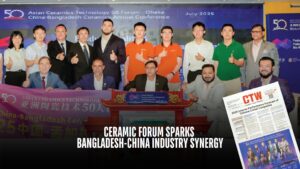
CERAMIC FORUM SPARKS BANGLADESH-CHINA INDUSTRY SYNERGY
In mid-July, Dhaka hosted the Asian Ceramics Technology 50 Forum at Hotel Amari’s Eden Grand Ballroom, marking a pivotal moment for Bangladesh’s ceramic industry. The event gathered leaders from Bangladesh and China to explore innovation, efficiency, and cross-border collaboration under the theme “Product Quality & Production Efficiency Enhancement and Investment Opportunities in Bangladesh – Win-Win Cooperation.” Delivering the welcome address, Irfan Uddin, general secretary of the Bangladesh Ceramic Manufacturers and Exporters Association (BCMEA), emphasised knowledge-sharing and sustainable growth. Praising China’s global leadership in ceramics, he said their participation reflected a shared commitment to regional cooperation. Chief guest Md Mamunur Rashid FCMA, acting BCMEA president and additional managing director of X Ceramic Group, highlighted the forum’s role in strengthening Bangladesh-China ties through joint ventures, technology transfer, and strategic investment. “Forums like this serve as a powerful platform for dialogue, innovation, and mutual growth,” he said, citing supportive government policies. The first technical session, chaired by Mohd Ziaul Hoque Zico, director of BCMEA and CEO of Hua Thai Ceramics, focused on quality and efficiency. Speakers included consultant Engr. Sadat H. Talukder and Luo Fei of Foshan Uniceramics Development. Discussants Saidur Rahman Khan of Akij Ceramics and Yang Shuilan of Foshan Lang Kun Electromechanical added insights. Yang noted rising consumer demand and costs, stressing that “quality and efficiency are not trade-offs but the double-helix genes of survival,” citing intelligent kiln control and AI visual inspection. Talukder pointed out Bangladesh’s low global market share—0.48% in tableware, 0.005% in sanitary ware, and 0.001% in tiles—despite resources, urging advanced kiln technologies, solar integration, and skill development. Khan said quality depends on customer satisfaction, warning that internal and external failures drive up costs, making productivity gains essential. The second session, chaired by Mahin Bin Mazher, adviser to BCMEA and MD of X Ceramic, explored cost reduction and tile performance. Mohammad Bayazed Bashar of DBL Ceramics proposed using locally sourced liquid sodium silicate to cut costs by 50%. He showcased DBL’s zero-waste strategy and cogeneration initiatives that saved 18.8 million standard cubic metre of gas—worth $1.2 million—with pilots targeting net-zero emissions by 2030. Liu Zhanjie of Foshan Uniceramics noted Bangladesh’s rising output. In 2023, the country produced 280 million square metre of tiles and 16 million sanitary ware pieces, with per capita tile consumption at 1.65 sqm—far below China’s 6.9 sqm in 2017 He projected tile output could reach 700–840 million sqm and sanitary ware 40–48 million pieces in a decade. AKM Ziaul Islam of Meghna Ceramic stressed lowering costs and boosting efficiency, citing the sector’s evolution since 1984 and labour advantages. Sun Bowen of Zibo Huayan detailed high-strength ceramic rollers and shuttle kiln technology, with 1.5 million-piece annual capacity. The final session, chaired by Dr Md Anwar Ullah FCMA, featured Md Mominul Haque of LankaBangla Investments, who cited GDP growth of 3.8–3.97%, inflation easing to 8.48%, and reserves rebounding to $31 billion. He noted Bangladesh’s emergence as the 9th largest consumer market by 2030. Muhammad Nazrul Islam of Sandhani Life Finance urged foreign investment, citing high dividend yields. Joanna Sun of Tangshan Hexiang highlighted sanitary ware expertise and 536 patents, including 37 inventions. The forum concluded with a shared vision: Bangladesh-China cooperation can drive innovation, reduce costs, and elevate Bangladesh’s ceramics industry to global prominence. Photo: Courtesy Written by Sajibur Rahman
Read More
Industry Leaders Unite for a Greener Bangladesh
A Call for Sustainable Transformation On January 30, 2025, the Sheraton Hotel in Dhaka hosted “Shaping Bangladesh: Designing Tomorrow, Building Today”, a landmark event organised by Ceramic Bangladesh Magazine. It brought together leaders from construction, real estate, and ceramics to champion sustainability and innovation in response to environmental challenges. Thought Leadership for a Greener Future As part of the series “Innovating for a Sustainable Future II”, the multi-panel format featured experts from ceramics, cement, and real estate. Moderated by Dr. Amir Ahmed of Daffodil International University, the panels included Muhammad Badrul Hassan (BBS Cables), Salehin Musfique Sadaf (GPH Ispat), Architect Faysal Ahmed (Concord Real Estate), AKM Ziaul Islam (Magna Ceramic), Mohammad Khorshed Alam (Akij Bashir Group), Asadul Haque Sufyani (Metro Cement), and Babor Hossain (Khadim Ceramics). Key Recommendations for Sustainability Panelists urged greater investment in R&D to reduce reliance on imports and foster local innovation. They called for collaboration across sectors to promote recycled materials and eco-friendly components. Suggestions included using fly ash and slag in cement, adopting hybrid or electric furnaces, and implementing energy-efficient manufacturing. Smart Materials and Policy Reform Experts advocated for smart glass technologies—low-E, solar, and self-cleaning—to boost building efficiency. They also recommended policy reforms to protect local manufacturers from zero-tariff imports and emphasized the need for government-run clay mines to secure raw materials for ceramic production. Bangladesh’s Tile Industry Comes of Age AKM Ziaul Islam highlighted the tile industry’s evolution since 1984. “We started with 100 mm tiles in one color. Now, we export to the USA,” he said. Despite high production costs, innovation has improved working conditions and sustainability, making the industry globally competitive. Real Estate and Domestic Innovation Architect Faysal Ahmed reflected on the sector’s overreliance on imports between 2000 and 2015. He stressed the importance of collaboration among architects, engineers, and academics to develop sustainable materials locally and reduce dependency on foreign technologies. Material Optimization for Environmental Impact Salehin Musfique Sadaf emphasized that optimized material use can reduce emissions and speed up construction. “Using 15,000 kg of cement instead of 20,000 kg without compromising strength means real sustainability,” he explained. Rethinking Cement and Energy Asadul Haque Sufyani discussed the carbon footprint of cement production and promoted fly ash and slag as eco-friendly alternatives. He stressed the need for affordable, sustainable materials and energy-efficient technologies. Energy Crisis and the Future of Glass Mohammad Khorshed Alam raised concerns about gas shortages affecting glass furnaces. He urged investment in hybrid furnaces and advanced technologies and called on architects to incorporate more locally produced glass to avoid overcapacity and unsold stock. Ceramic Bricks: A Smarter, Greener Choice Babor Hossain showcased ceramic bricks’ advantages over handmade red bricks—lower water absorption, higher strength, and reduced structural load. “They were used in national landmarks and can cut construction costs by 13 percent,” he said, advocating for government-run clay mines to sustain innovation. A Unified Path Forward The event concluded with a call for synergy among policymakers, industry, and academia. With rising climate risks and infrastructure demands, embracing innovation is not just strategic—it’s essential. Photo: Courtesy
Read More
Create your story in the alley of Kalabagan
magine walking down a road in a residential area when suddenly an old brick gateway catches your attention. A softly lit alley leads you towards a small, cosy restaurant with a beautiful antique and warm ambience. Located right beside the popular “Tea & Tea” restaurant and owned by the same person, this place remains crowded most of the time. Youngsters keep the restaurant lively throughout the day, while in the evening and at night families usually come here to dine. The cosy environment, ambience, décor, and food, everything is bound to make your time memorable. Architect Hashim Reza Opu, principal architect of Arch_Station, is the designer of this beautiful restaurant. He shared with us the design journey, concept, theme, and challenges. Designing a restaurant in such a compact area, only 12 by 23 feet, or 550 square feet in total, while accommodating seating, a counter, a spacious kitchen, an attached toilet, and even a semi-outdoor smoking zone, was a huge challenge. The building was old, and the designer wanted to keep its essence intact. Creating an antique-themed restaurant within a limited budget and compact space was also demanding. To meet the challenge, he began with the layout plan. By removing partition walls, he created a free-flowing space for the main dining area. Ar. Opu said, “Creating a memory, creating a story was the main concept of the design. Stories can be of many types — rock story, sad story, soft story, museum story. But what I wanted to tell was an old story. Kalabagan is a nostalgic place for many. People have memories here. I wanted to preserve that memory.” The walls, with plaster falling off in many places, were preserved in their natural undulated patterns. A basic colour coat was applied to the brick portions, and the lower plastered layer was finished with a thick skim coat in the colour of old lime plaster. This undulation gives the walls the vibe of a broken hill. Seating was carefully designed with ergonomics in mind. Sofa heights were adjusted for comfortable dining, and circulation was kept clear. Multiple seating modules make the compact space versatile: couple seating, four-person arrangements, and cluster options where two four-person tables can easily host eight. There’s also a single chair tucked into a corner by a bookshelf, where someone can sip a drink and read; either a book, or simply the whole atmosphere of the place. The handcrafted, polished tables are beautiful enough to spark curiosity about their story. Every detail starting from the tables to the antiques on the wall, from the windows to the ceiling ribs is thoughtfully designed to capture attention. The window grills, repurposed from the upper floors, were painted in vintage green and white. The ceiling features wooden ribs reminiscent of old zamindar houses, with concealed lighting that creates a warm ambience. The lighting adapts to the crowd, with three different moods: concealed ceiling lights, hanging lamps above tables, and directional spotlights highlighting the exhibits. The walls act as canvases, displaying art and antiques: rickshaw wheels with strip lights, a striking wood carving of a woman, an antique clock, a heavy bell, and more. Solid doors were partially replaced with glass, creating curiosity and ensuring visibility of the place. On one wall, an “urban elevation” was designed with two doors and two windows, and even a vintage grill was placed on a closed wall to continue the elevation effect. The counter is particularly unique. Built from the bricks of the existing walls, it alternates layers of wood, brick, and lime plaster, with lighted glass voids in between. This experimental design turned out beautifully. Behind it, a compact 8-by-12-foot linear kitchen supports the operation. One highlight is the “Van Gogh Corner,” where a large Café Terrace at Night painting adorns the wall. This veranda-like space serves as a smoking zone and makes visitors feel as though they are inside the painting. The artwork extends into the seating area and lighting, with warm illumination falling on stone flooring below. Every small detail contributes to the crafted atmosphere. The walkway, handmade with brass concrete textured using nails, is designed like a landscaped path inside a city alley. From its entryway to its tiniest detail, the restaurant tells a story; a story of memory and nostalgia, enriched with antiques and thoughtful design. The alley of beautiful memories is waiting for you in Kalabagan. Written by Sadia Tarannum
Read More
A Legacy Written in Brick and Trust
In 1992, when Dhaka’s middle class was just beginning to dream beyond modest apartments, a quiet vision began to take root. It was not about towers or market share but something simpler: “We stand for more than just buildings. We stand for trust, quality, and long-term relationships,” said Wasif Shamsul Alamin, Executive Director of Shamsul Alamin Group. That ethos, inherited from his grandfather, has since grown into one of Bangladesh’s most enduring real estate legacies. From its official founding in 2003, Shamsul Alamin Real Estate Ltd. built its reputation project by project, with a principle as straightforward as it was profound—do what you promise. “Our reputation wasn’t built on advertising slogans; it was built on living up to our core principles of trust and quality, project after project,” Wasif explained. Today, with more than 50 completed projects across Dhaka, the company’s presence stretches from Gulshan and Banani to Uttara, carrying forward a legacy of care, not just construction. Resilience in a Changing Market The journey has not been without challenges. Financing remains a major obstacle, as higher bank rates strain both buyers and developers. Rising costs of steel, cement, and land add further pressure. Yet the company continues to innovate, exploring modern methods like steel-frame construction and embedding sustainability features such as rainwater harvesting and energy-efficient materials. “We’re not driven by volume or profit. We’re driven by purpose—to create high-standard, thoughtfully designed living spaces,” Wasif said, underscoring how the firm positions itself in a market projected to reach $3.53 trillion by 2028. Living Spaces with Soul In Baridhara’s diplomatic enclave, the company’s philosophy finds expression in Alamin Tonmoy, a residential project that feels more like a sanctuary than a structure. With its lush greenery and private, one-apartment-per-floor design. Tonmoy embodies what Wasif describes as “homes, not just properties”—spaces where life breathes and privacy thrives. Back in Gulshan 1, Alamin Angur offers another lens into the company’s vision. Its three-bedroom residences reflect tranquillity and family living, designed for those who value both space and community. Angur demonstrates the company’s sensitivity to everyday life in Dhaka, marrying functionality with understated elegance. Workspaces for a Modern City If Tonmoy and Angur show the company’s care for private living, its commercial ventures display equal attention to the rhythm of modern business. In Banani, A&A Alamin Business Bay reimagines what a workspace can be. With thermal glass façades and wellness- oriented design, it is less about corporate square footage and more about creating an environment where businesses flourish holistically. At Kakrail, Alamin Capital Square rises with quiet confidence. Its design balances aesthetics with longevity, providing corporate tenants not only modern facilities but also a sense of permanence. From prayer spaces to community floors, the tower reflects a corporate philosophy grounded in dignity and practicality. Further north, in Uttara, Plaza 15 stands as a landmark of accessibility and commerce. Along the wide Gareeb-E- Newaz Avenue, the development’s positioning makes it a hub where business meets community. Its scale and convenience are matched by a forward-looking approach to safety, offering Dhaka’s new commercial class both ambition and assurance. Problems that Demand Solutions Yet behind this skyline of promise lies a sector grappling with deep-rooted problems. Financing remains perhaps the most pressing. As Wasif explained, interest rates on home loans now hover between 9 and 18 percent, making mortgages unaffordable for many aspiring homeowners. Developers, too, feel the squeeze as project financing grows increasingly expensive. “We saw the positive impact when government pushed for single-digit housing loans,” he recalled. “Those initiatives truly stimulated demand. To keep this growth going, we need a similar approach.” Land scarcity in Dhaka adds another layer of complexity. Prices continue to soar, putting pressure on companies committed to affordability. Add to this the volatile costs of raw materials—cement, steel, glass—and the challenge of offering high-quality housing at reasonable prices becomes all the more daunting. For firms like Shamsul Alamin Real Estate, the task is not only to build but to do so within constraints that demand creativity and resilience. A Sector of Immense Potential Still, the potential of the sector is undeniable. With rapid urbanisation and a rising middle class, demand for housing remains resilient—even in the wake of global disruptions like COVID-19. Over the past 15 years, Bangladesh’s real estate market has witnessed remarkable growth, now valued at $2.68 trillion and projected to expand to $3.53 trillion by 2028. “Urbanisation and rising incomes are driving huge demand for homes. The numbers speak for themselves,” Wasif observed, framing real estate as not just an economic driver but a reflection of the nation’s transformation. Charting a Way Forward The solutions, according to Wasif, must come from both industry and policy. Innovation in design and construction can help lower costs and speed up delivery. Techniques like steel-frame building, once an experiment, are now becoming viable tools for efficiency. Sustainable features—energy-saving materials, green spaces, rainwater harvesting—are being embedded not just for environmental reasons, but because they reduce long- term living costs for homeowners. Policy, too, must evolve. Affordable, long-term mortgage schemes would unlock home ownership for middle-income families, while easier access to credit for developers could keep projects moving forward. Collaboration between state and private sector, Wasif argued, is the key to ensuring that the housing dream remains within reach for millions of Bangladeshis. Building More than Structures For Wasif, the mission is deeply personal. “Working in this company means being part of something bigger than just business—it’s about contributing to a legacy of honesty, care, and creating lasting value in people’s lives,” he said. In his words, real estate is not about concrete alone—it is about the dreams of families, the pride of ownership, and the future of a city that is still writing its skyline. Shamsul Alamin Real Estate
Read More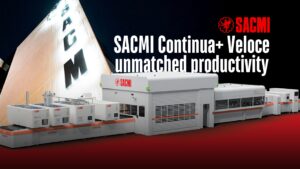
SACMI Continua+ Veloce: unmatched productivity
Available on all models, this new configuration delivers higher speeds and output rates up to 35,000 square meters per day. Further new features: it’s now possible to produce fired slabs up to 200 cm wide, with all the intrinsic advantages of a technology that sets the industry standard for productivity, versatility and low consumption. The number of solutions sold worldwide is now fast approaching 200. More productivity, less waste and lower consumption are the hallmarks of SACMI ceramic plants. Now, the Continua+ Veloce configuration takes those advantages to the next level. With this latest hyper-productive PCR version, the world-leading Continua+ slab and sub-size manufacturing technology now delivers higher speeds and a productivity up to 35,000 m2 per day for single machine. Now available on all PCR models, the Veloce configuration enhances the intrinsic advantages of this technology: for example, with the increased productivity, specific consumption at the compaction stage – already the world’s lowest – drops to just 0.04 kWh/m2. And there’s more. It’s also possible to combine the Veloce configuration with a broader compaction front to let manufacturers produce fired slabs up to 200 cm wide, vary thickness from 3 to 30 mm and obtain potentially infinite lengths. The increasingly popular Continua+ (the number of solutions sold worldwide is fast approaching 200) continues to be the leading ceramic slab and sub-size production technology. On Continua+, in fact, compacted scrap is always less than 1.5% regardless of the size, with all of it able to be recycled back into the process. Recipes and settings can be controlled flexibly via the operator panel, while motor-driven size changeovers maximize efficiency when handling complex, diversified production mixes. Quiet, easy to manage and with powerful results, Continua+ also reduces hydraulic oil requirements by over 90% compared to traditional or discontinuous presses. Slow, controlled de-airing ensures product uniformity and consistency, resulting in versatility with all body types and outstanding quality: a vital finishing touch to a solution that lies at the heart of the SACMI ceramic plant. More power, more control: alongside the latest Continua+ configurations, customers can also enjoy the advantages of new process control devices such as Optima+, part of the broad range of vision systems with which SACMI completes digitalization of the plant, simplifying its running while reducing the need for manual tasks.
Read More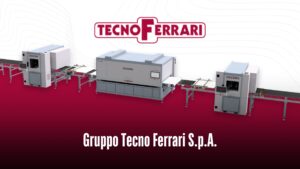
Gruppo Tecno Ferrari S.p.A.
Gruppo TecnoFerrari S.p.A. is a leading Italian company with over 55 years of experience in manufacturing and supplying industrial automation for ceramics. The company’s product range includes – Handling and storage systems – Intralogistics solutions – Digital printers – Vision, quality control, and end-of-line systems Thanks to the high-quality know-how, TecnoFerrari extends its service to all manufacturing sectors, with a focus on ceramics, automotive, glass, food and beverage, paper and tissue. TecnoFerrari guarantees maximum plant reliability and the efficiency of highly customized solutions. New Product Details TecnoFerrari introduces a new way of digital decoration and application. The Decora line-up includes super-rigid monocoque frames with configurations that can accommodate 2, 8 or 12 colour bars, offering flexibility to design an optimized decoration line. Decora 2 takes the concept of flexibility to the next level by allowing the enrichment of the ceramic surface through the use of functional inks. It offers a new way of digital glazing. Same layout, same raw materials, but different effects. Unique Features: Compact, Flexible and Movable. Uses: Ideal for creating special effects and functional surfaces. Benefits: No more static images: each product becomes a unique, personalized piece. This technique delivers outstanding performance, especially in the production of structured or functional surfaces, combining the mass of material with the definition of the printed design. It can synchronize with existing printing machines, enabling optical centering of the image on tile.
Read More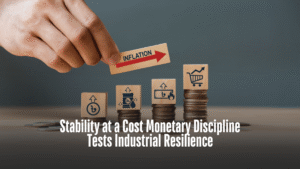
Stability at a Cost Monetary Discipline Tests Industrial Resilience
Businesses grappling with rising borrowing costs and surging energy prices are set to face additional pressure in the second half of this year, as the country’s central bank has decided to hold its policy rate steady at 10 percent for the July-December 2025 period. Bangladesh Bank has sent a clear message: the contractionary stance will remain in force until inflation falls below the 7 percent threshold. While the central bank frames this as a necessary measure to rein in stubbornly high prices and safeguard macroeconomic stability, the impact on businesses is already being felt. Key sectors such as ceramics, ready-made garments (RMG), and leather are contending with elevated borrowing costs and energy prices—pressures that threaten profitability and investment momentum. Prof Dr Mustafizur Rahman, distinguished fellow at the Centre for Policy Dialogue (CPD), warns that these rising costs are undermining business confidence and long-term growth prospects. He urges policymakers to focus on reducing non-borrowing expenses and to introduce targeted support measures. Without sustained reforms and a more balanced policy mix, he cautions, the trade-off between inflation control and economic vitality may become increasingly difficult to manage. Businesses Under Strain For Bangladesh’s industries, the continued high-interest environment presents a significant challenge. Sectors such as ceramics, RMG, and leather—cornerstones of the economy—are squeezed between rising input costs and shrinking access to affordable finance.\ “Maintaining a 10 percent policy rate is a cautious but necessary step in the present inflationary environment,” said Md Mamunur Rashid FCMA, senior vice president of the Bangladesh Ceramic Manufacturers and Exporters Association (BCMEA). “A disciplined monetary stance will help restore investor confidence, but it must be aligned with supportive fiscal policies,” he added. He highlighted the severe pressures facing manufacturers: “The ceramics sector relies heavily on a stable gas supply. Frequent gas shortages and substantial price hikes are pushing production costs up by 18–20 percent. This not only reduces profit margins but also makes debt servicing more difficult.” “Without stable exchange rates and smoother access to credit, businesses will struggle to remain competitive.” The RMG sector, already confronting new US tariffs, faces similar headwinds. Higher borrowing costs for working capital, coupled with uncertain global demand, threaten to dampen earnings and investment. Expert Analysis CPD’s Mustafizur Rahman said businesses such as RMG, ceramics, and leather are facing formidable challenges due to Bangladesh Bank’s contractionary policy, with its high policy rate of 10 percent. The elevated rate drives commercial bank lending rates upward, resulting in increased costs for businesses. He added that rising gas and electricity prices are further escalating operational costs, making it even more difficult for firms to sustain profitability. Prof Rahman suggested that Bangladesh Bank may consider reviewing the policy rate once inflation drops to 7 percent. In the meantime, policymakers should provide support to businesses by helping reduce non-borrowing costs. He noted that reducing inflation depends on multiple factors, including uncertainty reduction, law and order, political stability, fiscal policy, and market management. In Bangladesh, tightening monetary policy alone cannot produce the desired results. “The current contractionary monetary policy is being pursued at a time when the economy is experiencing investment stagnation,” he said. Prof Rahman argued that the rate should be revised once a sustained downward trend is observed. He also pointed out that while contractionary monetary policy aims to curb inflation, high borrowing costs undermine investment and raise the cost of doing business. Such pressures may weaken supply-side responses, which in turn could fuel inflation. Moreover, high inflation often triggers demands for higher wages, further pushing up prices. The trade-offs are therefore evident. According to Prof Rahman, reducing the cost of doing business and improving the overall business environment are particularly important when a contractionary monetary policy is in place. Otherwise, the very objective of such a policy could be undermined. BB Holds Firm Bangladesh Bank Governor Dr Ahsan H Mansur defended the decision, stating, “Until inflation comes below 7 percent, the policy repo rate will remain unchanged.” He argued that macroeconomic stability is a prerequisite for sustainable growth. Inflation has eased from a peak of 11.66 percent in July 2024 to 8.48 percent by June 2025. Gross foreign exchange reserves have inched up to $26.7 billion, and the adoption of a fully flexible, market-based exchange rate regime has brought a measure of stability to the currency market. The central bank cautioned that ongoing cost pressures from past currency depreciation and US tariff measures could hinder a sustained fall in inflation. Navigating the Road Ahead Experts emphasised that monetary tightening alone is not enough. Dr M Masrur Reaz, chairman and CEO of Policy Exchange Bangladesh, called the central bank’s stance “the right move in the current context” but warned it must be complemented by fiscal reforms, banking sector consolidation, and supply-side efficiency. Despite headwinds, growth is projected to rebound to between 5 and 5.5 percent in FY26. The central bank has signalled it may adjust the policy rate if businesses are severely affected by US tariffs, but only in a way that safeguards inflation objectives. For now, businesses must contend with tight credit, rising input costs, and global uncertainties. The resilience of firms and the pace of structural reforms will determine how well Bangladesh balances inflation control with economic growth. Written By Sajibur Rahman Photo: Courtesy
Read More
